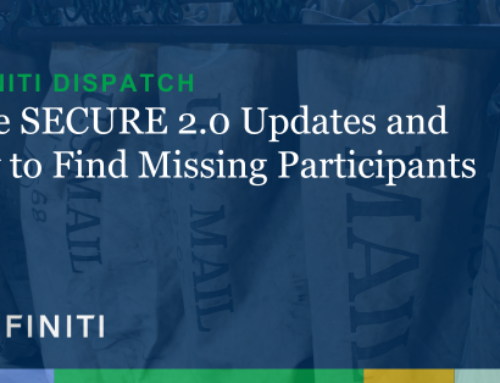If you are in the preliminary stages of a merger or acquisition at your organization — or even close to wrapping things up — what to do with the company retirement plan may not be at the top of your priority list to tackle. However, critical deadlines and timing considerations necessitate putting the retirement plan higher on your list.
When company ownership changes hands or part of a business is sold, it affects the retirement plan, such as a 401(k), and requires a decision to maintain, merge or terminate the plan. Working through the related details and reviewing and updating plan documents takes time and expertise. Your retirement service providers need to be in the loop about what’s happening so they can use their M&A expertise to help you get things in order.
M&A Scenarios
In terms of a merger and acquisition (M&A), there are three transaction scenarios that impact retirement plan participants and require significant plan document revisions.
These scenarios are:
- Asset sale – The selling company sells some or all its assets to the buying company. This can be a book of business, an office or a company division. The seller maintains its current ownership structure.
- Stock purchase – The selling company transfers ownership to the buying company. In this scenario, the ownership structure of the selling company changes.
- Merger – Two companies combine into one. The new company now owns all of what the two companies owned, including the retirement plans and the plan sponsorship responsibilities.
Timing is Everything
Working for a retirement service provider with extensive M&A experience, I can say without hesitation it’s a lot easier to help a plan sponsor before the close of their business transaction. If we learn about the M&A after the transaction occurs, some retirement plan options and decisions will already be made for you — and this provides you with less flexibility.
“Communicate early and often” is something we encourage our clients to do regarding their M&A transactions. By doing so, we can provide them the most help in terms of flexibility and options and timely address aspects that ensure a smooth transition for the affected retirement plans and participants.
Service Crediting Rule for an Asset Sale
Service crediting for the type of M&A (asset sale, stock purchase or merger) determines how employees’ years of service are treated through the transaction.
Let’s look at an asset sale first and see how service crediting works in this scenario:
- Employees of the selling company become terminated employees as of the sale transaction date. Plan participants are eligible to take a distribution from the selling company’s retirement plan.
- The selling company’s employees become new hires of the buying company on the transaction date and will be eligible for the buyer’s retirement plan according to plan eligibility terms.
- The buying company may choose to amend its plan to credit the employees’ prior service with the selling company. This service can be for eligibility, vesting or both.
In the asset sale scenario, the affected employees are eligible to take distributions from the retirement plan (e.g., a rollover into an IRA or lump-sum cash distribution), just like terminated employees from the seller’s plan can do.
Service Crediting Rule for a Stock Purchase
Employees’ years of service typically carry over from the selling company to the buying company in a stock purchase.
What happens with the seller’s retirement plan is up to the buyer in this scenario, and those options include:
- Merge the seller’s plan into the buyer’s plan (the most common scenario we see), making the employees ineligible to take a distribution because plan assets are simply transferred from one owner to the next.
- Terminate the seller’s retirement plan, which allows employees to take a distribution.
- Keep both plans and have each company maintain its plan. This is a less-common scenario due to a combination of factors, such as employee demographics, ramifications of a controlled group*, two retirement plans being more costly to maintain and harder (if not impossible) for multiple plans to pass nondiscrimination testing.
Service Crediting Rule for a Merger
The merger scenario is similar to a stock purchase in that:
- The surviving company becomes responsible for all plans sponsored or adopted by either company before the transaction. They can merge the plans and make a new one, terminate one plan or keep both.
- Generally, employees are credited with continued service at the new or surviving company, where their date of hire stays the same as it was in the originating company.
Asset Sale Example
Here’s a simplified example of an asset sale, a fictitious business named Salt & Spice Co. The company is doing well overall, but there’s one division that isn’t. So, Sugar & Spice Co. decides to sell its sugar division to Sweets Galore on November 30, 2021.
What this means is:
- Salt & Spice Co. maintains its current ownership structure.
- Employees in the sugar division are terminated effective November 30, 2021, which also becomes the employees’ start date at Sweets Galore.
- Sweets Galore can amend its plan to credit sugar division employees with their time at Salt & Spice Co., counting it toward Sweet Galore’s plan eligibility. (Note: An employer is not required to do this, but this is what happens in my example.)
It is important to note that if Salt & Spice Co.’s sugar division constitutes 20% of its total employee workforce, this transaction would constitute a partial plan termination. This means the affected participants become 100% vested in their Salt & Spice Co. retirement plan account balances. This is one example where speaking with your retirement plan consultant prior to the sale will provide you with more knowledge up front, as opposed to them learning about this after the fact.
Sweets Galore, in this scenario, has simply hired a group of new employees. They can amend their plan to allow for the employees’ years or service or have them wait for the eligibility period like any other new employee to the company.
Stock Purchase Example
Here’s another simplified example — this time for a stock purchase:
- Bert Inc. buys 100% of the stock of Ernie Inc. on December 1, 2021.
- Bert Inc. has a 401(k) plan with quarterly entry dates.
- Ernie Inc. has a 401(k) plan with monthly entry dates.
Bert Inc. now has two retirement plans to manage. If plan documents aren’t modified, employees would technically be eligible for both plans, which isn’t desirable. Well before the transaction, the retirement plan consultant will want to review each of the plan’s provisions, getting in front of things to ensure everything goes smoothly, including nondiscrimination testing and any possible protected benefits in each plan.
The IRS provides for a transition period as an amendment to each plan, but this must be done before the transaction. This allows for time to integrate the two plans without the worry of non-discrimination testing through the transition.
Bert Inc.’s plan excludes acquired employees during this transition period. The transition period runs from the date of acquisition on November 30, 2021, until the last day of the following plan year, which is December 31, 2022. This means the acquired employees from Ernie Inc. will become eligible for the Bert Inc. 401(k) on January 1, 2023, or earlier.
Bert Inc. can count all service with Ernie Inc. or just the service under the controlled group, which would be from November 30, 2021, on.
During the transition period, Bert Inc. will have time to integrate its new employees into the company payroll and onto the recordkeeper platform and give participants time to schedule investment advice education sessions. If both plan documents include the transition period provision, it makes the M&A activity easier to manage and the process feel less rushed for both the employer and employees.
M&As and Retirement Plan Takeaways
You likely know by now the driving themes for this topic, but repetition is a good thing in the often-complicated world of retirement plans — so be sure to:
- Give your retirement plan consultant early notice about your M&A.
- Decide what to do with the legacy retirement plan and how you’ll manage service crediting.
- Get all related plan documents reviewed and updated.
- Review your plan provisions to include the transition period to allow more time for essential activities.
My team and I encourage you to lean on your consultant so we can help guide you through the transition process. M&As are all-consuming, so why not let Definiti help with one critical aspect – the retirement plan(s).
M&A and Retirement Plan FAQs
We’re here to answer your M&A-related questions. In the meantime, here are answers to the most common ones we receive about this topic.
Q. If a company acquired another company several years ago and left the retirement plans separate, never taking action to consolidate them, what should they do now?
We can help. We will review the plan documents and the provisions in each plan, including employee eligibility. We will likely go back and do testing to make sure the plans are non-discriminatory and they meet current retirement industry regulations. Most likely, filings and corrections will need to be made, and your Definiti consultant will work with you to straighten things out.
Q. How much time does the IRS allow for a retirement plan to transition when a company is sold?
The transition period, which needs to be stated in the plan document, provides the company time to integrate until the end of the plan year following the plan year in which the transaction occurred.
Q. Can Definiti help identify a control group and work through related issues?
Yes, we can. And, no surprise, timing is everything. The more time we have before the transaction, the more we will be able to help. We will take into account aspects such as ownership percentages and any family relationships in the company. Our analysis will specify what should be a control group and how this designation affects the plan.
Q. Could separate retirement plans run indefinitely at a company?
Yes, but that’s a complicated topic for the reasons mentioned earlier (e.g., employee demographics and non-discrimination testing) and one that’s best discussed with your retirement plan consultant.
Q. What about defined benefit (DB) plans related to an M&A? What’s important to consider there?
We have expertise in this area, too, and will review the DB plan for its promised benefits to employees, any unfunded liabilities and any long-term obligations. Terminating a DB plan is more involved than closing a 401(k) and often takes more time to address fully. We have to make sure the plan is not overfunded because there could be significant tax implications for the employer if it is.
We’re Here to Help
Ready to continue the conversation about retirement plans in an M&A scenario?
Definiti has experience working through M&A transactions of all sizes, from those affecting a few employees to many more. Talk with your Definiti representative or contact our sales team at 1-888-912-3653 or sales@definiti-llc.com.
—

Haley Erickson, QKA
Manager, Defined Contribution Administration
Haley joined Definiti in 2020 and has worked in the retirement services industry since 2010. In her role, she leads a team of knowledgeable, talented retirement consultants who work with defined contribution and defined benefit plans. Haley has a passion for helping others grow in the industry and enjoys being a mentor who can explain the intricacies of the retirement plan industry. She specializes in solving complex plan design issues and compliance testing scenarios.
Haley holds a Qualified 401(k) Administrator (QKA) designation with the American Society of Pension Professionals and Actuaries.
—
This material has been prepared for informational purposes only and is intended to provide general information on matters of interest in the area of qualified retirement plans and is distributed with the understanding that the publisher and distributor are not rendering legal, tax or other professional advice. Readers should not act or rely on any information in this article without first seeking the advice of an independent tax advisor such as an attorney or CPA.





